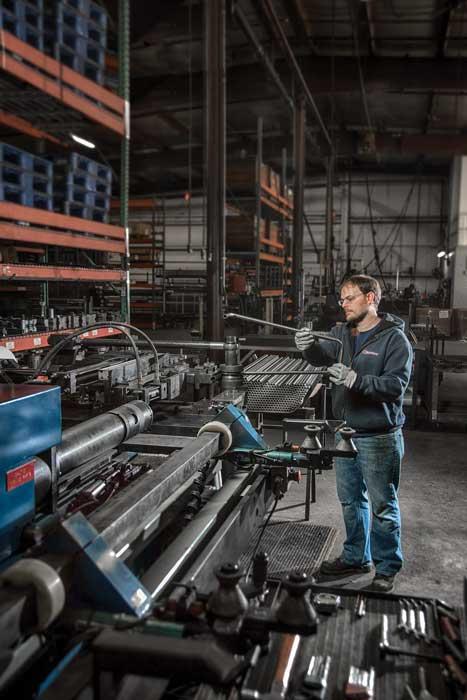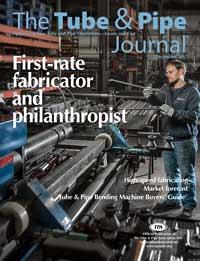- FMA
- The Fabricator
- FABTECH
- Canadian Metalworking
Categories
- Additive Manufacturing
- Aluminum Welding
- Arc Welding
- Assembly and Joining
- Automation and Robotics
- Bending and Forming
- Consumables
- Cutting and Weld Prep
- Electric Vehicles
- En Español
- Finishing
- Hydroforming
- Laser Cutting
- Laser Welding
- Machining
- Manufacturing Software
- Materials Handling
- Metals/Materials
- Oxyfuel Cutting
- Plasma Cutting
- Power Tools
- Punching and Other Holemaking
- Roll Forming
- Safety
- Sawing
- Shearing
- Shop Management
- Testing and Measuring
- Tube and Pipe Fabrication
- Tube and Pipe Production
- Waterjet Cutting
Industry Directory
Webcasts
Podcasts
FAB 40
Advertise
Subscribe
Account Login
Search
U.S. Venture shows that fabrication and philanthropy go hand-in-hand
Automotive products wholesaler makes the world a better place
- By Eric Lundin
- November 16, 2017
- Article
- Shop Management
While every manufacturing company has an abiding interest in making money and turning a profit, this isn’t the whole story. Every manufacturer is part of a chain or a network that strives to make better products that ultimately make the world a better place. Whether the latest innovation saves labor, provides more convenience, enhances safety, or offers advancement in some other area, manufacturers are part of a continuous progress that improves people’s lives by bringing better products to market.
This isn’t the only way a business can improve the world, of course. A little generosity can go a long way, and a lot of generosity can do wonders. This is a core value of U.S. Venture, Appleton, Wis. One of the largest privately held companies in the state, it has exhibited unwavering generosity since it was established, a hallmark that has accompanied the firm on its decades-long course of growth and prosperity. Founded in 1951 by the tirelessly entrepreneurial Schmidt brothers—Art, Ray, and Bill—the company relies on values the brothers learned from their parents, Albert and Margaret Schmidt.
A Foundation in Fuels
Albert Schmidt’s career planted the seed that eventually would become a vast corporate entity. He had a fuel delivery route, and his sons started a company that is still heavily involved in fuels to this day. Founded as Schmidt Brothers Oil in 1951, the company was renamed U.S. Oil in 1966, and then in 2010, the company rebranded itself as U.S. Venture Inc., with the vision to be the very best value-adding distributor of products that vehicles consume in North America. In addition to distributing fuels and lubricants, it is nationwide distributor of products that are needed under every passenger car and light truck: tires, brakes, handling components, and exhaust.
The company’s vision describes its market, and the Schmidt brothers would have had trouble finding a market that was destined for greater expansion. The nation’s automobile market nearly tripled since the company was founded, increasing from 6.275 million units sold in 1951 to 17.865 million in 2016.
Throughout decades of growth, the company has become four separate entities.
- U.S. Oil is a value-adding distributor, marketer, trader, and terminal operator of fuels and renewable energy products. As such, it moves 28.5 million barrels of oil per year through pipelines, 1.8 million barrels by barge, 1 million by rail, and nearly a million by truck. It also operates 21 terminals, 18 of which it owns. Products include refined petroleum products, oil, and biofuels.
- U.S. AutoForce® distributes more than 12 brands of tires for applications as varied as passenger, recreational, light truck, performance, commercial, and agricultural. It also carries brake systems, suspension and ride control products, exhaust systems, and lubricants.
- U.S. Lubricants carries lubricants for essentially every application imaginable: automobiles; heavy equipment used in construction, forestry, mining, military, and marine applications; and industrial and metalworking lubricants for manufacturers and paper mills.
- U.S. Gain provides compressed natural gas to fleet operators. The company is building a network of stations along major trucking corridors to provide easy access to its fast filling stations. Its short-term goal is to establish 100 stations throughout the U.S. and Canada.
Hard work, integrity, and a willingness to take calculated risks were the values that the elder Schmidt instilled in his sons, and that mindset is what pushed the brothers and now a team of dedicated employees to grow the business to become a much larger and diversified company with more than 1,300 employees across the country. The growth came from a combination of relentless efforts to explore new business opportunities and careful financial planning.
Fabricating Steel Pipe
For a company turning over more than 30 million barrels of oil annually, running 21 oil terminals, and keeping an inventory of nearly 90,000 tires in its warehouses, not to mention countless brake calipers, shock absorbers, and myriad other suspension and exhaust items, it seems almost beyond belief that it would have a pipe fabrication shop. Yet, it does.
The company has always been a distributor of nationally recognized automotive products, but decades ago when it saw an opportunity in the exhaust business, it decided to make its own exhaust pipes. Dick Vosters, who manages the pipe shop that operates as part of the U.S. AutoForce business, recalled that the pipe shop opened in 1980 and, as a recent high school graduate, Vosters was hired to fabricate pipe in 1983.
Under the guidance of Ray Schmidt, U.S. AutoForce purchased its second and third bending machines late in 1983, and the company needed to ramp up its staffing in the pipe shop quickly.
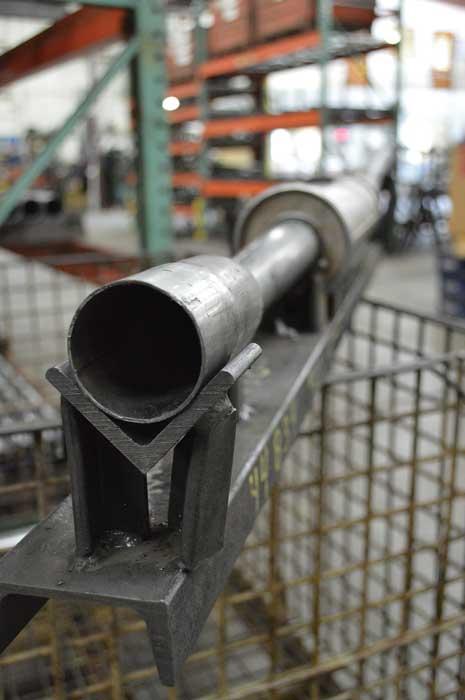
Figure 1
U.S. AutoForce built about 300 check fixtures for its decades of work in making aftermarket exhaust systems.
The timing was good. The price of crude oil, which had doubled in 1979, was falling rapidly, and the two back-to-back recessions of 1980 and 1981 were history. The 1980s would be a decade of growth and prosperity. The next recession, which occurred in 1990, was a long way off.
Technical conferences, educational books, and instructional videos about bending tube were a long way off, too.
“We did a lot of learn-on-the-go in the early days,” Vosters said. In those days, most automakers outfitted cars with exhaust systems made from steel. They didn’t last long, so business was good. The fabricators at U.S. AutoForce did a lot and along the way they learned a lot, both in fabricating and management. Over the decades, the pipe shop personnel have applied the entrepreneurial spirit exhibited by the Schmidt brothers as the industry and U.S. AutoForce have evolved.
Fabricate and Verify. Making an exhaust pipe is one thing; verifying that it will fit is something else. The pipe shop needed check fixtures, and many of them. Because automotive exhaust systems have a little leeway, the fabrication staff knew they could handle making their own check fixtures (see Figure 1).
If a customer needs something more precise, U.S. AutoForce outsources the design and construction of precision or certified check fixtures, and its quality control office is outfitted with a noncontact coordinate measuring machine (CMM).
Cross-training. As the fabricating capabilities multiplied, so did the degree of specialization, with each worker doing one thing—welding, running a bender, polishing parts—really well. While this was fine in the past, these days cross-training is common. One of the benefits is immediate: When a team member takes some time off, the shop can continue to produce parts. Long-term benefits, which accrue to employer and employee alike, include a bigger variety of duties, which staves off boredom and keeps team members engagement high with less likelihood of repetitive-motion injuries. As of October 2017, the pipe shop had worked 3,000 days without a recordable injury (dating back to 2009).
“We had a little resistance when we started cross-training,” Vosters said. “Now, I don’t think anyone would want to go back to doing just one job.”
Work Cells. Many manufacturers thrive on using assembly lines and similar setups, but a fabricator’s work changes often, and assembly lines aren’t known for their flexibility. The assembly line concept has given way to work cells, and U.S. AutoForce has taken this idea further than many.
“We put most of our end formers on casters and installed drop cords in a few places around the shop so we have power where we need it,” Vosters said. By having some mobile equipment, the staff can create a work cell in just a few minutes.
Diversifying. The exhaust business isn’t nearly as large as it once was. Until the 1980s, most exhaust components were made of steel, and they lasted just a few years. It was common that an automobile needed its exhaust system replaced a couple of times during its service life, but all that changed when OEMs transitioned to stainless steel and the aftermarket industry switched to aluminized steel.
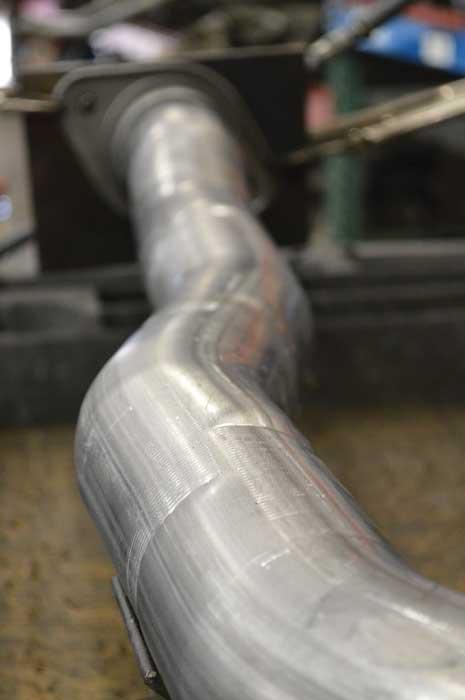
Figure 2
To say that exhaust systems require complex geometries would be an understatement. The staff of U.S. AutoForce’s pipe shop has many decades of collective experience, which comes in handy when dealing with parts like this one.
U.S. AutoForce leveraged its equipment and fabrication knowledge to branch out into other areas, and its work spans the bending spectrum. It has the expertise to make some complex parts, the equipment needed to knock out simple parts quickly, and nearly everything in between (see Figure 2).
It’s not the biggest tube-and-pipe fabrication shop you’ll ever see, but it has a lot of capability. The shop staff draws on decades of experience to do nearly anything in fabrication, including bending (round, oval, square, and rectangular, with or without mandrel), end forming (reducing, expanding, flaring, swaging, and beading), various other fabrication processes (cutting, notching, punching, coping, drilling, and welding), and finishing (powder coating, anodizing, and polishing).
It has offset the decrease in the exhaust business by making inroads into other industries, making components for consumer, medical, and industrial products. All of the company’s bending machines are equipped with CNC, and the majority are mandrel-capable (see Figure 3). The shop bends material as light as 18 gauge, and its benders have enough torque to bend square tube up to 2 inches by 2 in. with 0.250-in. wall thickness.
Its efforts to branch out have paid off. Exhaust components now make up just 35 to 40 percent of the total work done in the pipe shop and, in keeping with its success in diversifying, the pipe shop became a new entity, U.S. Custom Manufacturing.
And, yes, it is keeping an eye on the future by cooperating with Kimberly High School. U.S. Custom Manufacturing is a partner in a vocational program that provides bona fide job experience for the next generation of fabricators (see Figure 4).
Philanthropy Made to Order
For all the business that U.S. Venture does and all the revenue it generates, it’s doubtful that any Schmidt has ever bragged about the company’s financial success. The header of the home page of the company’s website says it all, listing five content areas: About Us, Businesses, Career Opportunities, Giving Back, and Newsroom. Only one of those hints at making money; three are company information and one is philanthropy.
Philanthropy is so important to the family and to the company that in 1985 the brothers founded a family foundation in honor of their parents: the U.S. Venture/Schmidt Family Foundation Inc., which is incorporated as a separate business entity.
In 1986, Bill Schmidt founded the U.S. Venture Open, a golf outing that has raised more than $33 million dollars for the U.S. Venture Fund for Basic Needs since its inception.
Today, the foundation has a full-time staff. It focuses its efforts on granting money to organizations that assist the disadvantaged, striving help individuals and strengthen communities. In 2016, its philanthropic impact topped $10.4 million–—$2.05 million in collaborative grants, $3.61 million raised at the U.S. Venture Open, and $4.78 million in corporate giving and grants.
It also looks beyond U.S. borders by supporting a community center called Victory Community Development Center (VICODEC) in Ongata-Rongai, Kenya. VICODEC provides local children from the slums with an education, nutrition, and medical care to help them grow and succeed despite the desperate living conditions. It educates more than 650 students annually and feeds more than 3,050 every day.
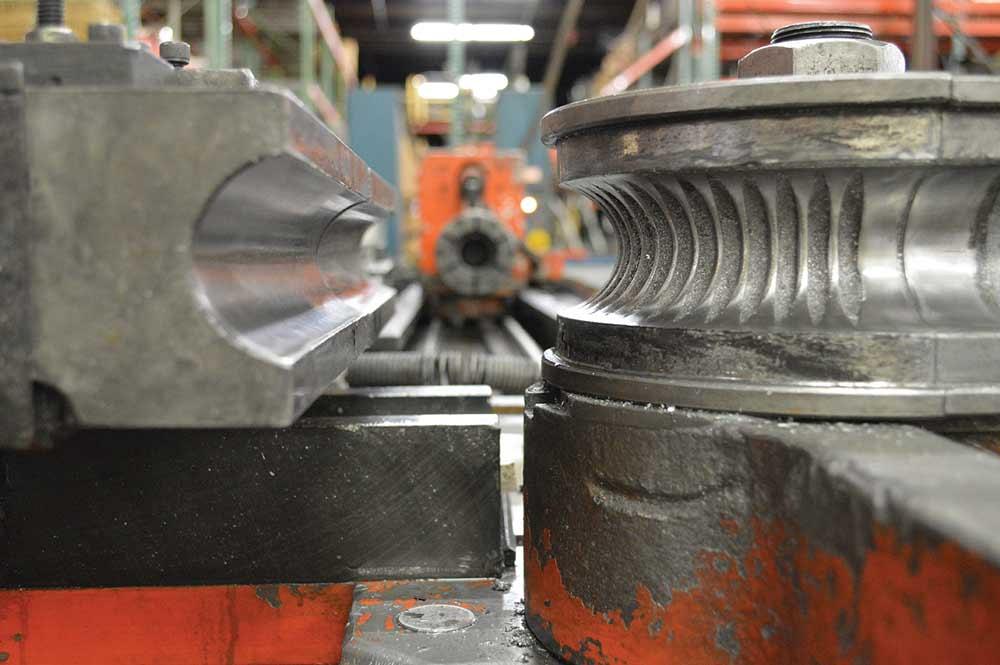
Figure 3
Bending exhaust components successfully hinges on using the right tooling. In many cases, a mandrel is necessary to prevent the tube from collapsing. Also, the industry uses a unique sort of bend die, one that has a series of deep grooves. These grooves guide the metal as it flows, giving it a place to go.
The Schmidt family doesn’t direct all of the philanthropic efforts. It’s actually a democracy in that every associate has a voice. The company guarantees to each employee eight hours of paid time off annually without restriction so they can do volunteer work for any charitable organization they choose. The foundation also matches every dollar up to $1,000 donated by every team member to any charitable group.
Philanthropy might not be the fabric of U.S. Venture, but it’s the stitching that runs throughout the organization, and it seems to work to the benefit of recipient and donor alike. The company’s success and generosity have been followed by more success and led to further generosity, creating a virtuous cycle that illustrates the adage, “What goes around, comes around.” In eastern Wisconsin and other communities in which U.S. Venture has a presence, what goes around are the blessings of the Schmidt family and the generosity of the many team members who work for the company.
U.S. Venture Inc., 425 Better Way, Appleton, WI 54915, 920-739-6101, www.usventure.com
Apprenticeships for the next generation of fabricators
Nearly every manufacturer is affected by the skilled labor shortage these days. Many are doing something about it, and one such company is U.S. Venture, Kimberly, Wis. Since it was founded in the Green Bay area in 1951 as Schmidt Brothers Oil, the company has been an ardent supporter of the local community as both an employer and a philanthropist. These days, it also is a partner in providing apprenticeships for local high school students interested trying their hands at manufacturing.
Kimberly High School (KHS) provides a substantial number of classes in technical fields, said Steve Masanz, who serves as the Architecture, Construction, and Engineering Academy program coordinator and a technology education instructor for the school.
“We have eight technical staff who teach classes in construction, welding, engineering, metals, audio-visual, and graphic arts,” he said. “We have three classes in the welding series. The last one is a dual-credit class, so the student earns college credit for it. The metals program also includes three courses. The first includes turning, welding, and machining. The second and third classes are more advanced machining.”
Of the 1,600 students who attend KHS, more than 1,000 take at least one of these courses, Masanz said, and word about the program has gotten around.
“We get a lot of support from local industry,” he said. “They provide tours, monetary assistance, and materials for the technical education program.” Furthermore, some provide apprenticeships for the 15 students who have chosen to go that route. Working hand-in-hand with Wisconsin’s Department of Workforce Development, KHS works to help students look beyond their high school years, Masanz said.
“We try to help them find a career, not a job,” he said.
The Youth Apprenticeship program is thorough, outlining the responsibilities of all involved in making the experience a success—parent, school, instructor, coordinator, employer, and student. Getting a student into an apprenticeship position starts with some legwork on the part of the program coordinator.
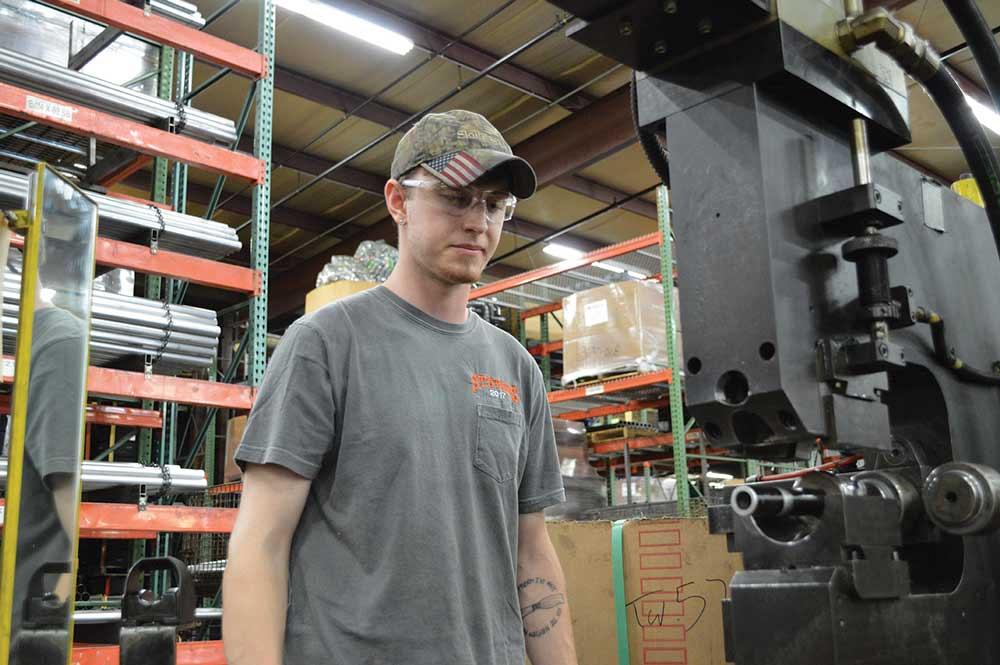
Figure 4
In addition to its philanthropic activities, U.S. Venture is an educational partner, cooperating with Kimberly High School’s vocational program.
“We learn about the business to determine if the student will be a good fit,” Masanz said. From there, the student submits a resume and goes through an interview, just as he would for any other job. The employer is required to assign a mentor, who receives training before the student is hired. The employer, instructor, parent, and student must participate in regular progress reviews during the student’s employment. Furthermore, the coordinator monitors each student’s progress and visits each employer regularly to be sure the employer is providing duties that are relevant to the apprenticeship program.
The employer commits to providing at least 450 hours of work throughout the school year, which adds up to 15 to 20 hours per week. The student gets more than just a taste of the workplace; the student commits to the workplace.
U.S. Custom Manufacturing, a division of U.S. Venture, is in its third year of participating in the program, said Dick Vosters, the company’s manufacturing manager and sales representative. U.S. Custom Manufacturing doesn’t use a single progression for every student, but keeps it flexible based on the student’s background and capability.
“For the first few weeks, the student mainly looks over the shoulder of each equipment operator,” Vosters said. “Based on the knowledge the student has, and the classes he has taken, little by little the student starts to provide some assistance. It takes a few weeks to really understand the machines, the processes, and the safety aspects of working in a fabrication shop.”
Somewhere around the four-week mark, the student starts working somewhat independently, with oversight from one of the associates. The student isn’t an equipment operator but an assistant, in a role akin to that of an intern.
“Our role is education, not production,” Vosters said. To the end, he makes sure the student works with everyone in the shop, just as the student would as a full-fledged member of the work force. Although a student probably would never run something as complicated as a tube bender, Vosters strives for as much exposure as possible.
“It’s important to work with all of the personalities, learn about all of the equipment, and understand all of the processes,” Vosters said. Vosters thinks that the shop personnel also benefit from having a student on the shop floor, and not just because they get some help.
“People always want to help a young worker, especially one that has already established that he’s interested in a particular career, and I think it sometimes rejuvenates the veterans to share their experience,” he said.
About the Author

Eric Lundin
2135 Point Blvd
Elgin, IL 60123
815-227-8262
Eric Lundin worked on The Tube & Pipe Journal from 2000 to 2022.
About the Publication
subscribe now

The Tube and Pipe Journal became the first magazine dedicated to serving the metal tube and pipe industry in 1990. Today, it remains the only North American publication devoted to this industry, and it has become the most trusted source of information for tube and pipe professionals.
start your free subscription- Stay connected from anywhere

Easily access valuable industry resources now with full access to the digital edition of The Fabricator.

Easily access valuable industry resources now with full access to the digital edition of The Welder.

Easily access valuable industry resources now with full access to the digital edition of The Tube and Pipe Journal.
- Podcasting
- Podcast:
- The Fabricator Podcast
- Published:
- 04/30/2024
- Running Time:
- 53:00
Seth Feldman of Iowa-based Wertzbaugher Services joins The Fabricator Podcast to offer his take as a Gen Zer...
- Trending Articles
Team Industries names director of advanced technology and manufacturing

Orbital tube welding webinar to be held April 23

Zekelman Industries to invest $120 million in Arkansas expansion

Push-feeding saw station cuts nonferrous metals

3D laser tube cutting system available in 3, 4, or 5 kW

- Industry Events
16th Annual Safety Conference
- April 30 - May 1, 2024
- Elgin,
Pipe and Tube Conference
- May 21 - 22, 2024
- Omaha, NE
World-Class Roll Forming Workshop
- June 5 - 6, 2024
- Louisville, KY
Advanced Laser Application Workshop
- June 25 - 27, 2024
- Novi, MI
























